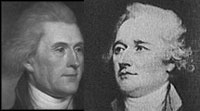 |
||
  |
||
|
|
The First American Party System: A Documentary Timeline of Important Events (1787-1800)Lesson Two of the Curriculum Unit: The First American Party System: Events, Issues, and PositionsGuiding Questions
Learning ObjectivesAfter completing the lessons in this unit, students will be able to:
How the handout will be used will differ from class to class, depending largely on the background students bring to the lesson and the available time. Though not comprehensive, it attempts to provide the highlights in a brief form. It offers links to short secondary accounts and primary documents and a small selection of quotes from some of each. Several classroom options are available. The timeline can be given to students as a handout to use for reference. The class can review the entire timeline or relevant portions of it without reference to the links. Student groups or individuals can be assigned primary documents and asked to select one or two especially pertinent excerpts. (If desired, students can use the Written Document Analysis Worksheet, on the EDSITEment-reviewed website Digital Classroom, as an aid to their analysis.) Student groups or individuals can be assigned one of the five sections of the timeline to study in order to share with the class the significant events from those years. The teacher can use the timeline as the basis for a lecture or a handout custom-made for the needs of the class. Students can use the timeline as the basis for their own timeline(s) of the events they consider most significant. However you choose to use the handout, the goal is to provide the conditions for a discussion of the following:
AssessmentStudents who have completed this lesson or who have sufficient prior knowledge should be able to respond effectively to the bulleted discussion points above orally or in writing. You might consider using a jigsaw strategy as a way of having the class examine each of the questions in depth. Divide the class into three groups and assign one of the first three questions to each of the groups. Once the students have completed their examination of the timeline and related documents, have each group report their conclusions back to the entire class. When the class has completed this exercise, move on to the fourth question and ask the students to decide what additional events or circumstances were critical to the formation of these first parties.Previous lessonNext lessonReturn to curriculum unit overview: The First American Party System: Events, Issues, and PositionsSelected EDSITEment Websites
Standards Alignment View your state’s standards |
||||||||||||||||||||||||||||||||||||||||||||||||||||||||||||||||||||||
  |
||
| EDSITEment contains a variety of links to other websites and references to resources available through government, nonprofit, and commercial entities. These links and references are provided solely for informational purposes and the convenience of the user. Their inclusion does not constitute an endorsement. For more information, please click the Disclaimer icon. | ||
| Disclaimer | Conditions of Use | Privacy Policy Search
| Site
Map | Contact
Us | ||
